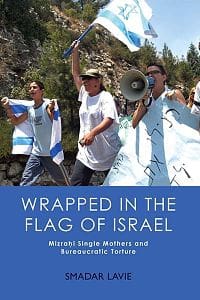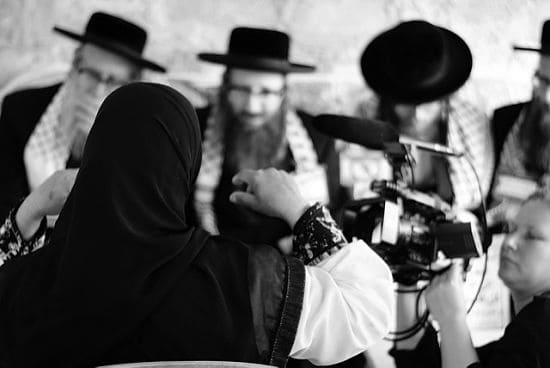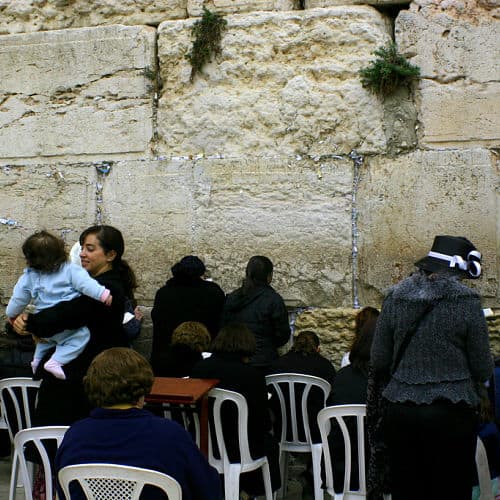How can we conceive of the contemporary relationship between race, poverty, and bureaucracy? Smadar Lavie’s latest publication, an account of her experience as a Mizrahi single mother dependent on Israeli state welfare, provides a valuable contribution to all those concerned with bureaucracy, neoliberalism, and the on-going occupation of Palestine by Israel. By shedding light on the little-known but demographically dominant Mizrahi population of Israel, Lavie answers questions that the audience may have perhaps not anticipated. She also provides a vital contemporary overview of Israel’s racial hierarchy and its impact on regional politics.
 Lavie sets the ethnically complex scene by differentiating between Ashkenazi (those of European origin) and Mizrahi (those who emigrated from Arab and Islamic areas) Jews. She then distinguishes between those Palestinians in the Occupied Territories and within what is known as “’48”, or present-day Israeli borders. Locating the majority of the Mizrahim as socioeconomically inferior to the Ashkenazim, Lavie explains the arrival of Mizrahi Jews to Israel in the 1960s as a result of the Ashkenazi elite’s need to establish a Jewish labour force and demographic buffer to the fleeing Palestinians. As a civilising ideology, Zionism aimed to reform Israel’s growing population to an Ashkenazic paradigm, using the notion of ‘chosen people, chosen land’ to establish a binary construction of ethnicity that opposes Jews to Arabs. Therefore, upon their arrival to Israel, the Mizrahim were encouraged to shed their Oriental habits and languages and ‘Ashkenazify’, or ‘Europeanise’, themselves according to the Zionist standard.
Lavie sets the ethnically complex scene by differentiating between Ashkenazi (those of European origin) and Mizrahi (those who emigrated from Arab and Islamic areas) Jews. She then distinguishes between those Palestinians in the Occupied Territories and within what is known as “’48”, or present-day Israeli borders. Locating the majority of the Mizrahim as socioeconomically inferior to the Ashkenazim, Lavie explains the arrival of Mizrahi Jews to Israel in the 1960s as a result of the Ashkenazi elite’s need to establish a Jewish labour force and demographic buffer to the fleeing Palestinians. As a civilising ideology, Zionism aimed to reform Israel’s growing population to an Ashkenazic paradigm, using the notion of ‘chosen people, chosen land’ to establish a binary construction of ethnicity that opposes Jews to Arabs. Therefore, upon their arrival to Israel, the Mizrahim were encouraged to shed their Oriental habits and languages and ‘Ashkenazify’, or ‘Europeanise’, themselves according to the Zionist standard.
The Arab Mizrahim were largely settled in the border areas of the new Israeli state and were financially and socially neglected in favour of the Ashkenazim. With less hereditary wealth, larger families, and lower incomes, the Mizrahim are now a demographic majority but a cultural minority, underperforming and underrepresented in most areas.
With a higher number of single-parent families combined with a higher rate of unemployment and a lower rate of professionalisation and education, Lavie explains how the Mizrahim are rendered dependent on a state that is reluctant to support them. Following the Oslo Accords of the early 1990s and the waves of global neoliberalism that preceded it, the Israeli state began to retract its welfare programmes, allowing NGOs to fill its previous functions while outsourcing labour to cheaper foreign markets. Neoliberalisation also impacted the legal protections afforded to single parent families, with no legal function enabled to extract child support payments from absent fathers. These cuts impacted the large population of Mizrahi single mothers hardest, rendering them dependent on ever decreasing welfare payments. The impoverishment of the Mizrahim and their shared Arab heritage with the native Palestinian population might give cause for collaboration between the two groups, but in fact the Mizrahim remain predominantly Zionistic and anti-Arab in outlook.

A relatively new subject in anthropology, existing work on the Mizrahim tends to focus on their marginalisation (Khazzoom 2003, Chetrit 2000) and their transition as immigrants to Israel (Shohat 1999, 2003). Lavie’s alternative focus on single mothers is particularly interesting, as a more religiously traditional community but with a high number of single parent households, the Mizrahi single parent is dependent on the state for financial support and kept as such by being made increasingly marginal to the workforce. Particularly interesting is Lavie’s account of her own positionality in relation to her subject: due to a series of unpredictable circumstances, Lavie finds herself trapped in Israel, unable to secure employment despite her previous status as a Berkeley professor due to her Mizrahi status, and thus suddenly forced into the position of auto-ethnographer. Acknowledging that auto-ethnography is often rejected by the British and North American academies as somehow more unreliable than the narratives of informants, Lavie utilises the particular circumstances of her position to provide a unique insight into the pain of the experiences shared by her and her fellow welfare mothers. This is emphasised by her use of a more unconventional ethnographic style, which includes letters, diary entries, the use of anger in ethnographic writing, encounters with other Mizrahim both in her personal and professional life, and her own struggle against the state’s reclassification of her identity in its own terms.
What is crucial to understanding the plight of Mizrahi Jews, and what Lavie skilfully makes clear, is how the Israeli state denies its Jewish citizens the right to an identity politics outside the boundary of ‘Jewish’.
As the Zionist state operates on an ethnic binary of ‘Jew’ opposed to ‘Arab,’ the Mizrahim are in an especially complex position as former Arabs, encouraged to shed their ‘uncivilised Arab ways’ but also unable to completely deny themselves their past, and perhaps unable to identify how the Ashkenazi-led state uses this as a tool against them. Lavie describes her informants as trapped in such a position without any agency, unable to speak out against a state that oppresses and denies them their ever shrinking welfare allowances while fashioning itself as their protector.
It is here that lies my chief criticism of both the book and the practice of auto-ethnography itself: while the depth of Lavie’s own experience as a Mizrahi welfare mother is fascinating, it leaves the breadth of knowledge of others lacking.
Where we understand intimately the emotional and financial aspects of Lavie’s own demotion to the role of welfare-dependent single mother and what this entails, the use of auto-ethnography as means of representing all Mizrahi single mothers silences their voices by omission. While some testimony of her contemporaries appears, it is used primarily to show their politics in relation to the Palestinians and the Ashkenazim, not as voices of their interactions with the state. Though Lavie’s privilege as a half-Mizrahi academic émigré to the United States is clearly acknowledged, in her use of auto-ethnography we are denied the experiences of those Lavie claims to speak for. Consequently her privilege in her ability and status to voice the pain she seeks to document and share also serves as a means by which to silence her fellow Mizrahi single mothers.
However, this is not to the detriment of the analysis of the pain inflicted on her by the bureaucratic encounter. Describing with a Geertzian thickness the myriad ways in which welfare dependency exhausts and humiliates its beneficiaries, Lavie expands upon the work of Handelman (2004) to expose the concept of bureaucracy as a modern instrument of torture. Adapting Scarry’s (1985) plus-minus model of torture to show how the bureaucrat unwittingly abuses the mother in a plus-plus (mutually repellent) relationship whereby the bureaucrat is unable to simply and efficiently solve the single mother’s needs, and the mother is unable to avoid this encounter, and indeed is forced to undertake it with increasing regularity in order to survive. As a result the bureaucratic encounter becomes self-perpetuating and ritual-like in form, requiring the Mizrahi welfare mother to repeatedly submit to its punishment in order to eke out the meagre provisions of the state.

Lavie then theorises the essence of this bureaucracy: GendeRace, a neologism for the dual means by which the Ashkenazi-Mizrahi distinction is formed and thus Mizrahi single mothers are prevented from achieving the social mobility attained by their Ashkenazi contemporaries. Consequently, Lavie shows that the unilateral front against the Arab enemy that the regional ethnic privilege of Jewish identity demands overpowers the call for an internal identity politics for those damaged by the gendered and racialised aspects of the Israeli bureaucratic engine.
Lavie’s ethnography fills a chasm in the anthropology of Israel that documents the inter-ethnic hierarchies and how these are impacted and enforced by the state. In doing so she situates the Mizrahim not only in relation to their own subordination within Israel, but also in relation to the on-going inability of the Israeli government to forge peace with Palestine. What is fascinating is the detail given to the ways in which the Mizrahim are played off against the Palestinians in Israel’s media as a means of deflecting attention towards and away from the conflict depending on the needs of the government in the eyes of the national and international media.
As a relatively new topic in anthropology, an auto-ethnographic account of the Mizrahim provides a unique insight, and Lavie is particularly well qualified in detailing a peculiarly unusual removal of status and privilege and how this might impact upon one’s identity in relation to neoliberalism and the ethnic binary of Jew versus Arab formulated by the Israeli state. Beginning and ending the book with scenes from Mizrahi protest against their treatment by the Israeli state, Lavie shows how the single mothers are manipulated and bought off to be silenced, ominously indicating at one point that a Palestinian suicide bomber is capitalised upon, even given a security exception, by the government as a distraction technique. Ultimately, as an institutional ethnography of bureaucracy, Lavie paints an intimate and personal picture of the pains of poverty and state-dependency, using her privilege to speak for those with less. However, as an ethnography of an under-privileged population, especially a majoritarian one, I wonder if Smadar Lavie might be able to share with us in the future more testimony from the broad umbrella of experience that is to be a Mizrahi Israeli.
References
Chetrit, S. (2000) Mizrahi politics in Israel: Between integration and alternative. Journal of Palestine Studies 29(4): 51-65.
Handelman, D. (2004) Nationalism and the Israeli State: Bureaucratic Logic in Public Events. Oxford: Berg.
Khazzoom, A. (2003) The great chain of Orientalism: Jewish identity, stigma management, and ethnic exclusion in Israel. American Sociological Review 68(4): 481-510.
Scarry, E. (1985) The Body in Pain The Making and Unmaking of the World. Oxford: Oxford University Press.
Shohat, E. (1999) The invention of the Mizrahim. Journal of Palestine Studies 29(1): 5-20.
Shohat, E. (2003) Rupture and return: Zionist discourse and the study of Arab Jews. Social Text 21(2): 49-74.
Author’s Response
Writing book reviews is integral to the circulation of ideas and dialogue between scholars. This daunting job often goes unappreciated. I am grateful to Anja Ryding for the time and care she put into this important public service and for her cogent summary and analysis of Wrapped in the Flag of Israel.
There seems to be two errata, however, that I would like to address for potential readers of my book.
First, although I am currently a scholar-in-residence at U. C. Berkeley and completed my Ph.D. at this fine institution in 1989, I was not a professor at Berkeley before my forced stay in Israel from 1999 to late 2007 — The book states clearly that I was an associate professor at U. C. Davis. Since, as the reviewer aptly points out, my background and personal experience are the basis for the autoethnographical component of Wrapped, it seems important to be clear on this matter.
Second, Wrapped in the Flag of Israel dedicates a whole chapter to discussing the socio-economic effects of Mizrahi labor migration to Palestine from 1882 onwards. 1882 marks the beginning of Ashkenazi Zionist settlement of Palestine as well. The book does not discuss Mizrahi immigration to the state of Israel in the 1960s, as the reviewer claims in her opening paragraph. Indeed, Chapter One emphasizes the importance of understanding the role of pre-Nakba Mizrahi migration to Palestine, rather than the large waves of 1950s migrants.
Prof. Smadar Lavie
*********
Featured image (cropped) by couturiere7 (flickr, CC BY 2.0)




Writing book reviews is integral to the circulation of ideas and dialogue between scholars. This daunting job often goes unappreciated. I am grateful to Anja Ryding for the time and care she put into this important public service and for her cogent summary and analysis of Wrapped in the Flag of Israel.
There seems to be two errata, however, that I would like to address for potential readers of my book.
First, although I am currently a scholar-in-residence at U. C. Berkeley and completed my Ph.D. at this fine institution in 1989, I was not a professor at Berkeley before my forced stay in Israel from 1999 to late 2007. The book states clearly that I was an associate professor at U. C. Davis. Since my background and personal experience are the basis for the autoethnographical component of Wrapped — as the reviewer aptly points out — it seems important to be clear on this matter.
Second, Wrapped in the Flag of Israel dedicates a whole chapter to discussing the socio-economic and cultural effects of Mizrahi labor migration to Palestine from 1882 onwards. 1882 marks the beginning of Ashkenazi Zionist settlement of Palestine as well. The book does not discuss Mizrahi immigration to the state of Israel in the 1960s, as the reviewer claims in her opening paragraph. Indeed, Chapter One emphasizes the importance of understanding the role of pre-Nakba Mizrahi migration to Palestine, rather than the large waves of 1950s immigration.